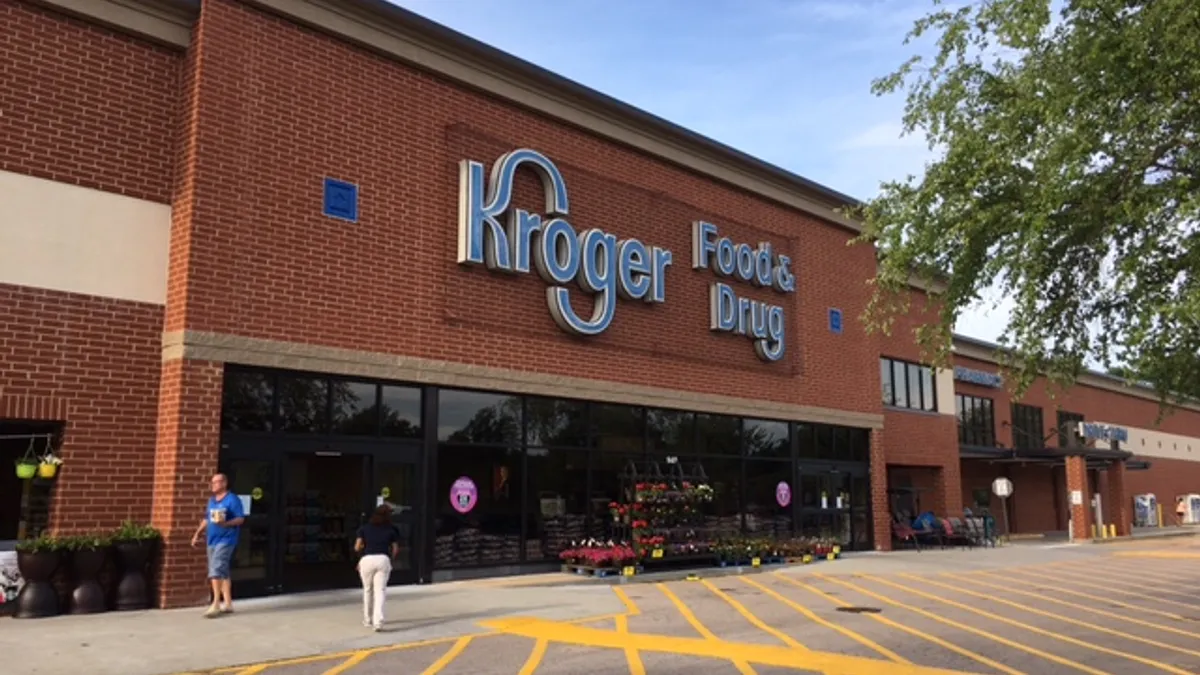Dive Brief:
- Kroger announced it's exploring the sale of its convenience store division, which includes 784 stores across 18 states and generates $1.4 billion in revenue, according to a company release. Mike Schlotman, Kroger’s chief financial officer, told attendees at the company’s investor conference yesterday that the retailer wants “to see if [the stores] are of more value to somebody else that runs just c-stores versus the value they create for our shareholders inside of our company.”
- Kroger also announced a growth strategy called “Restock Kroger” that includes a mixture of cost cutting and strategic investments in data, digital innovation, store updates and pricing. Executives expect the strategy to produce $400 million in profit by 2020 and $4 billion in free cash flow over the next three years.
- The grocer reaffirmed its guidance on the year, saying it expects same-store sales of 0.5% to 1% and net earnings of $1.74 to $1.79 per diluted share.
Dive Insight:
At Kroger’s annual investor conference Wednesday, chief executive Rodney McMullen talked about the grocer’s drive to capture sales not just across the grocery industry, but across the broader $1.5 billion food industry.
“If you’re eating, we want to serve you, and unless it’s dinner at a white tablecloth restaurant, that’s a meal we should be able to provide to you,” he told attendees.
The sale of its convenience store division, which has seen increasing consumer interest in fresh items and foodservice, would seem to work against this mission. But Kroger’s obligation to rein in costs and focus on its supermarkets amidst escalating competition and a nearly 40% stock price decline this year seemed to outweigh the opportunity.
The company’s “Restock Kroger” initiative is all about generating more value from those existing grocery stores. Long known for being a data-driven retailer eager to get ahead with digital solutions and store technology, Kroger wants to deepen and accelerate its development in these areas even as it whittles down costs.
Space optimization, for instance, is something Kroger has been doing for the past few years. Now, the company wants to deepen its use of data to arrange products for maximum impact at the individual store level. It also wants to bring optimization capabilities to more stores — from 6% of its locations this year to 20% to 30% over the next few years.
Stuart Aitken, CEO of Kroger’s 84.51 analytics firm, used an example of stocking more pet products at a store where company data had identified a high number of pet owners. It could also mean building out a pasta aisle with more of the company's Private Selection brand if sales are strong.
“We’ll lay out the store around what’s most important to our customers,” he said.
Kroger officials said they plan to continue investing in price, with nearly $4 billion spent in this area since 2001. The grocer also plans to invest 200% more next year in key technology areas, including digital, store and payment technology. “Scan, Bag, Go,” a mobile app that lets shoppers scan and pay for items using their mobile phones, will expand from 20 stores to 400 next year as Kroger addresses a major pain point for consumers while also keeping pace with competitors like Walmart that offer similar technology.
One of Kroger’s most effective tools to build customer loyalty, officials noted, is its ClickList online shopping platform. The grocer plans to roll out the service to more stores while also making its user interface more sophisticated. Like Amazon, Kroger’s ClickList offers personalized product recommendations based on the items shoppers buy. Since building these recommendations into its search tool, Kroger has seen a 33% increase in “add to cart” clicks.
Underlying many of these efforts is the rich data Kroger gathers through its 84.51 analytics firm. With this, Kroger sees 96% of every transaction, according to Aitken, including what other stores customers shop, what car they drive, whether they use an Android or iPhone, and numerous other metrics.
There are other assets, too, including one of the strongest private label portfolios in the business. Between 2011 and this year, Kroger’s store brands have increased sales by 37%, to $20.5 billion.
But is it all enough to spur growth for a company that’s contending with competitive threats from every angle? Investors cheered the news that Kroger might sell its c-store division, with stocks gaining 7% in early trading. But since then the share price has moderated. Among many industry observers, there seems to be an understanding that Kroger is doing what it has to do in a challenging market.
“Kroger has been a net market share taker for a long time,” Ben Bienvenue, an analyst with Stephens who covers Kroger, recently told Food Dive. “They have been and still are a really strong operator, but there are just an abundance of competitive threats right now.”
Others, on the other hand, believe Kroger needs a transformative acquisition or deal to help it stand out from the crowd. Speculation swirled last week that Kroger might merge with Ahold, though the source of the rumor was questionable. Karen Short, analyst with Barclays, meanwhile, has recommended Kroger acquire a meal kit company, or perhaps enter into a joint venture with British e-grocer Ocado, which has been eyeing an entry into the U.S. for years.
Kroger has dipped its toe into meal kits, restaurants and other concepts. But to make a statement and grab more of that $1.5 billion opportunity, it may need to go big, according to Short and others.
“Given the stepped-up level of competition from both traditional and non-traditional competitors, thinking ‘outside-the-box’ (similar to Walmart’s acquisition of Jet.com) will be increasingly essential for it to thrive in a rapidly changing landscape,” Short wrote in a recent note to investors.









